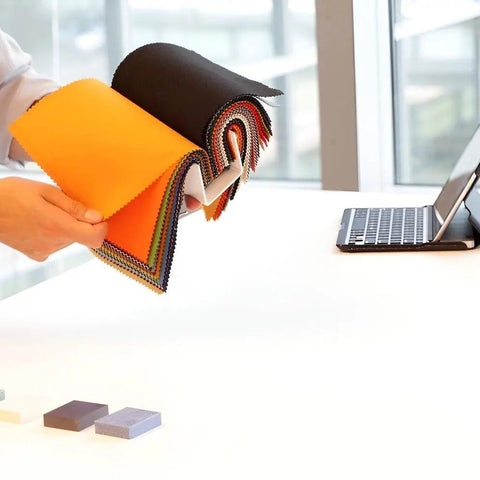Polyester is a chemical compound composed of molecules bonded together in long, repeating chains. But is polyester fabric waterproof? Without a water-resistant coating or laminate, untreated polyester is classified as water-resistant rather than fully waterproof. Polyester's hydrophobic nature helps it repel light moisture, but it is not inherently waterproof and typically requires additional treatments to achieve true waterproofing. To make a fabric that is 100% polyester waterproof, it would need to be treated with a waterproof coating or treatment.
What kind of material do you want in your furniture? You want something cozy and durable, which is why waterproof and water-resistant fabrics are so popular. Synthetic fabrics, such as polyester and nylon, are commonly used; however, other materials, like rubber or PVC, are naturally or inherently waterproof, making them excellent alternatives for waterproof applications. A bean bag is perfect for sinking into in any environment, and rain won’t make it soggy. Polyester has low moisture absorption properties, a tight weave, and is quick-drying, allowing sweat and moisture to evaporate quickly from its surface, making it a practical choice for such uses.
When buying furniture, the waterproof factor is crucial, especially for soft furnishings like beanbags, where spills are common. Let’s explore what makes a good waterproof bean bag that can withstand drink spills and outdoor weather. Sealed seams are important for creating a truly waterproof fabric, ensuring that water does not seep through the stitched areas.
Introduction to Polyester
Polyester fabric is a go-to material in the textile industry, prized for its impressive durability and water-resistant properties. Made from polyethylene terephthalate, polyester is a synthetic fabric that withstands everyday wear and tear, making it a preferred choice for a wide range of applications, from outdoor gear to household items like bean bag chairs. While polyester fabric is not completely waterproof on its own, its tightly woven structure helps it resist water penetration better than many natural fibres. This makes polyester a smart choice when you need a fabric that can withstand moisture, spills, and the demands of an active lifestyle. Whether you’re looking for a reliable barrier against the elements or a material that will last, polyester offers a balance of strength, versatility, and water resistance that’s hard to beat.
What is the Best Fabric for a Bean Bag?
A bean bag needs durable fabric, leading to debate over the best material. Faux leather is popular for modern styles, known for strength and fire resistance, making it great for outdoor use. Corduroy is comfortable and can be used to make a bean bag larger. Cotton is soft and cozy for indoor use, but it absorbs water, making it not ideal for waterproof bean bags. Polyester, on the other hand, is a water-resistant fabric, making it more suitable for outdoor or spill-prone environments than cotton. That’s where polyester comes in. Polyester is less strong than nylon but has excellent resistance to fading, stretching, and shrinking. Additionally, polyester is generally more affordable than nylon, making it a cost-effective option for many. Many of our outdoor bean bags use a PU Coated Polyester fabric.
Nylon is often the go-to fabric for outdoor gear due to its strength and durability. When considering alternatives to polyester, other materials such as vinyl, rubber, or PVC are also used for waterproof bean bags.
Types of Polyester Fabrics
Polyester fabrics come in a variety of types, each designed to meet specific needs. For example, polyester fleece is a thick, cozy fabric often used in outerwear and blankets, providing warmth and comfort. Moisture-wicking polyester is engineered to pull sweat away from the skin, making it ideal for activewear and sports clothing where keeping dry is essential. Recycled polyester is an eco-friendly alternative, created from recycled plastic bottles, and offers the same durability and water-resistant capabilities as traditional polyester. Each type of polyester fabric has its strengths—whether it’s keeping you warm, dry, or helping the environment—so choosing the right one depends on how you plan to use it. From everyday clothing to specialised outdoor gear, there’s a polyester fabric suited for nearly every purpose.
So, is Polyester Fabric Waterproof?
Polyester itself is waterproof, unlikely to absorb moisture, and can be woven tightly to prevent water from passing through. This makes it one of the best materials for waterproof bean bags. The more layers of polyester, the better the waterproofing factor, as these layers fill the microspaces between strands. Polyester can also be coated with sealant for extra protection. Waterproofing is often achieved by applying a thin layer of polyurethane membrane or laminated layers to the fabric, which creates a flexible and effective waterproof barrier. A waterproof coating or membrane significantly enhances polyester’s ability to repel water, making it suitable for high-performance applications. A water-repellent coating and sealed seams create a more reliable barrier against water, resulting in a truly waterproof fabric. For instance, PVC-coated polyester creates a waterproof barrier and is highly durable for harsh weather conditions. Water-resistant finishes are also commonly used to enhance the water resistance of polyester. If you want a waterproof bean bag, look for a polyester tag.
Water Repellent Treatments for Polyester
To enhance the water-resistant properties of polyester fabric, manufacturers often apply specialised water-repellent treatments. These treatments can be added by dipping, spraying, or finishing the fabric, creating a protective layer that helps repel water and prevent it from soaking in. Popular options include durable water repellent (DWR) coatings and polyurethane laminate (PUL) treatments, both of which enhance the fabric’s ability to resist moisture. While these coatings enhance polyester's water-resistance even further, it’s essential to note that their effectiveness can decrease over time, particularly with frequent use or washing. Additionally, applying a water-repellent treatment may slightly alter the feel or flexibility of the fabric, but it’s a worthwhile trade-off for added protection against spills and wet conditions.
Are Bean Bags Commonly Made from Polyester?
Given polyester’s benefits, are bean bags commonly made from it? While nylon is another option with its advantages, both polyester and nylon are synthetic fabrics widely used in bean bags. However, they do not always offer the same level of water resistance or durability. Nylon is known for its exceptional strength and resilience, making it more durable and suitable for demanding applications than polyester. Both polyester and nylon are prevalent on the bean bag market, so you’ll always have choices. If you can’t find nylon, polyester is a safe alternative, especially with kids and pets around, as well as for outdoor use.
What Environments Suit Bean Bags?
Even with water-resistant material, you might wonder where to put your bean bag. Thanks to modern prevention materials, you shouldn’t worry about leaving bean bags outside. Waterproof bean bags are suitable for patios, lawns, and under parasols. They’re also great indoors, in living rooms, kitchens, and bedrooms. Polyester is also widely used in outdoor clothing because of its everyday waterproof qualities, making it suitable for a variety of environments. They fill a space well!
How Would You Clean a Waterproof Bean Bag?
Since polyester is somewhat waterproof, how do you clean a bean bag made of it? You can’t just machine wash it, as this can damage or remove the waterproof lining. Instead, wipe it down with a cloth, using as little moisture as possible to avoid seepage. For cleaning, take the cover off and determine the material. Vinyl or suede will require hand washing or dry cleaning. The effectiveness of a waterproof treatment on polyester can vary and may degrade over time with use and exposure to the elements. Prolonged exposure to moisture can further reduce the effectiveness of waterproofing, making it less effective in keeping the wearer dry during extended periods of rain or water contact. Polyurethane Laminate (PUL) makes polyester waterproof while maintaining flexibility and breathability, offering a balanced solution for such applications.
How Durable Are Waterproof Bean Bags?
The existence of waterproof bean bags implies durability. Durability lies mostly in the fabric. Non-weatherproof fabrics, such as cotton, aren’t durable after rain. Polyester holds up best against rain and dampness, offering excellent value for money. A tight weave in polyester fabric enhances both its durability and water resistance, especially when combined with additional waterproof treatments. Double stitching and memory foam also improve durability. Polyester tends to be more breathable than nylon due to its moisture-wicking properties, making it a comfortable and practical choice. Look for these elements in bean bags for indoor use, which can also be waterproof.
Can Waterproof Bean Bags Still Be Cozy Enough?
Yes, of course! Waterproof bean bags adapt to their environments and are cozy for all ages. Despite the perception that waterproof fabrics like polyester can be uncomfortable, research has led to the development of finer, more durable fabrics. A polyester bean bag is just as cozy as a cotton one. They come in various designs, like oversized ones with blanket attachments or chair shapes, and can still be waterproof. Polyester is malleable and can be layered for both durability and comfort.
Comparison to Other Fabrics for Bean Bags
When selecting the best fabric for bean bags, it’s helpful to compare polyester to other popular options, such as nylon, cotton, and vinyl. Polyester is valued for its water-resistant properties and durability, making it a solid choice for bean bags that need to withstand everyday use. Nylon is another synthetic fabric known for its strength and excellent resistance to abrasion, making it ideal for outdoor gear and bean bags that will see heavy use. Cotton fabric, while soft and breathable, tends to absorb water and isn’t as suitable for wet environments. Vinyl stands out as a completely waterproof material that’s easy to wipe clean, making it perfect for outdoor use or areas prone to spills. Ultimately, the right fabric depends on where and how you’ll use your bean bag—polyester is great for indoor comfort and moderate water resistance, while nylon and vinyl offer more reliable barriers for outdoor or high-moisture settings.
Bean Bags and Polyester: Perfect for Your Furniture Needs
We all want furniture that's practical, comfortable, and cozy. Bean bags have been around since childhood, and many would love to own one. When investing in outdoor bean bags, prioritise the waterproof factor. When you need a waterproof bean bag, look for a tag made of polyester. Polyester is one of the most durable and water-resistant materials. We trust you've enjoyed our article and now know the answer to the question: Is polyester fabric waterproof?




